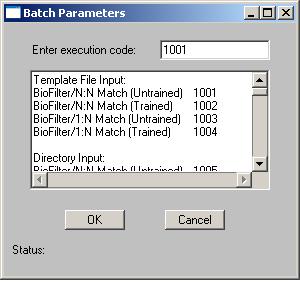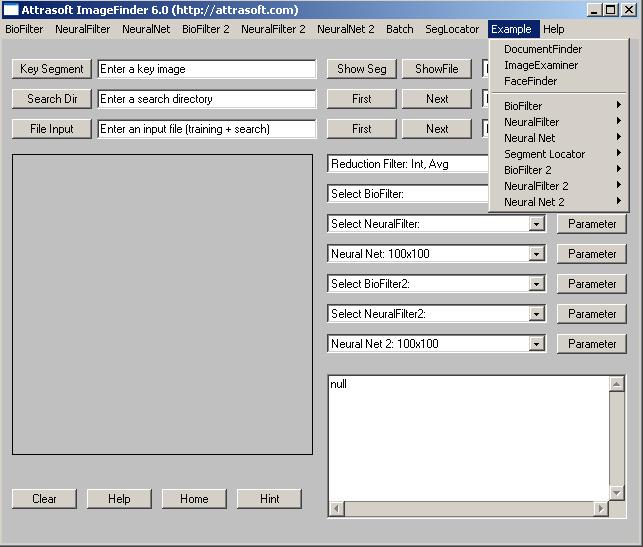11. Batch Job
11.1 Creating Batch Code
11.2 Sample Batch
11.3 Overview
11.4 Batch Execution Code
11.5 BioFilter Examples
11.6 NeuralFilter Examples
11.7 NeuralNet Filter Examples
When matching images, you will need to select many filters. For each selected filter, you will need to select many parameters.

Figure 11.1 Batch Menu.
One simple approach is:
Edge Filters: Sobel 1 (or Sobel 2)If this is your first matching and you do not like the default values, you will have go through a trial and error process. However, if this is your second matching, you can save everything in the first matching and then use a batch command. Click the "Batch/Save" menu command; you will get the batch file in the text area.
Threshold Filters: Dark Background 128
Clean Up Filter: None.
NeuralNet Filter:Segment: AutoSeg 10
Segment Cut: Trial and Error
Symmetry: Default
Blurring: Start with 5, Trial and Error
Sensitivity: Start with 50, Trial and Error.
Throughout this chapter, we will use the two examples in the three previous chapters:
- Label Recognition Problem
- Logo Recognition Problem
The Filter selection and Parameter setting can be saved in one of 5 files by the following commands:
Batch/Save
Batch/Save 2
Batch/Save 3
Batch/Save 4
Batch/Save 5
These 5 commands create the batch codes and save them to 5 different
files. The batch codes can also be recalled later by clicking the following
commands:
Batch/Open
Batch/Open 2
Batch/Open 3
Batch/Open 4
Batch/Open 5
These 5 commands open existing batch codes.
A matching requires you specify the following Filters and their Parameters:
Image Preprocessing
Edge Filters;Normalization
Threshold Filters; and
Clean Up Filter.
Reduction Filter.Feature Recognition
BioFilter;Pixel Level Recognition
Neural Filter.
NeuralNet Filter or ABM Filter.Multi-Layered Pixel Recognition
BioFilter 2;A typical batch code looks like this:
NeuralFilter 2;
ABM Filter 2.
[ImageFinder 6.0]
executionCode=1001[Input]
trainFileName=None[Image Processing Filters]
searchDirName=None
fileInputName=None
edgeFilter=1[Reduction Filter]
thresholdFilter=1
cleanUpFilter=1
reductionType=0[BioFilter]
segmentCut=0
sizeCut=0
borderCut=0
lookAtX=0
lookAtY=0
lookAtXLength=0
lookAtYLength=0
bioFilter=10[NeuralFilter]
bioFilterPercent=50
bioFilterMode=2
bioFilterFinal=0
bioFilterCutOff=0
neuralFilter=0[Neural Net]
neuralFilterPercent=20
neuralFilterMode=0
neuralFilterSize=2
neuralFilterFinal=0
neuralFilterCutOff=0
neuralNetFilter=0[BioFilter 2]
segmentX=0
segmentY=0
segmentXlength=0
segmentYLength=0
symmetry=3
rotationType=0
translationType=0
scalingType=0
sensitivity=50
blurring=5
internalWeightCut=100
externalWeightCut=100
segmentSize=0
imageType=1
fileDisplayType=0
autoSegment=0
neuralNetMode=0
bioFilter=0[NeuralFilter 2]
bioFilterPercent=20
bioFilterMode=2
bioFilterFinal=0
bioFilterCutOff=0
neuralFilter=0[Neural Net 2]
neuralFilterPercent=20
neuralFilterMode=0
neuralFilterSize=2
neuralFilterFinal=0
neuralFilterCutOff=0
neuralNetFilter=0
segmentX=40
segmentY=40
segmentXlength=220
segmentYLength=220
symmetry=3
rotationType=0
translationType=0
scalingType=0
sensitivity=70
blurring=20
internalWeightCut=90
externalWeightCut=10000
segmentSize=0
imageType=1
fileDisplayType=0
autoSegment=0
neuralNetMode=0
This batch code has the following sections:
Batch Execution Code
Input
Image Processing Filters
Reduction Filter
BioFilter
Neural Filter
NeuralNet Filter or ABM Filter
BioFilter 2
NeuralFilter 2
ABM Filter 2
When you create the batch code by command Batch/Save, you will see
the above code in the text area. When you open a batch file by command
Batch/Open, you will see the above code in the text area.
This section will explain how batch code is used.
(1) Create an application using the ImageFinder;
(2) Save the setting to batch code with the following commands:
Batch/SaveYou might find the following online note useful in helping you remember what you saved into these 5 batch files:
Batch/Save 2
Batch/Save 3
Batch/Save 4
Batch/Save 5
Batch/Notes(3) Later you can open the batch file with the following commands:
Batch/Open
Batch/Open 2
Batch/Open 3
Batch/Open 4
Batch/Open 5
(4) To load the parameter without running, click:
Batch/Load.(5) To load the parameter and run, click:
Batch/Run.The Batch/Save command saves the following information:
- Filter selection and their Parameter settings;
- The template file, which contains the records from images.

Figure 11.2 Excecution Code Window.
There are many commands in the ImageFinder. Each command has an integer for identification. This integer is called Batch Execution Code. The �Batch/Run� command uses this code to run the command specified by the batch file. To find the batch code for each command, click:
Batch/Set Execution CodeYou will see a textbox and the following codes:
Template File Input:
BioFilter/N:N Match (Untrained) 1001
BioFilter/N:N Match (Trained) 1002
BioFilter/1:N Match (Untrained) 1003
BioFilter/1:N Match (Trained) 1004
Directory Input:
BioFilter/N:N Match (Untrained) 1005
BioFilter/N:N Match (Trained) 1006
BioFilter/1:N Match (Untrained) 1007
BioFilter/1:N Match (Trained) 1008
File Input:
BioFilter/N:N Match (Untrained) 1009
BioFilter/N:N Match (Trained)
1010
BioFilter/1:N Match (Untrained)
1011
BioFilter/1:N Match (Trained)
1012
Template File Input:
NeuralFilter/N:N Match
1013
NeuralFilter/N:(N-1) Match
1014
NeuralFilter/1:N Match
1015
Directory Input:
NeuralFilter/N:N Match
1016
NeuralFilter/N:(N-1) Match
1017
NeuralFilter/1:N Match
1018
File Input:
NeuralFilter/N:N Match
1019
NeuralFilter/N:(N-1) Match
1020
NeuralFilter/1:N Match
1021
Template File Input:
NeuralFilter/a1 + a2 ==> b2
1022
NeuralFilter/a1 + a3 ==> b3
1023
NeuralFilter/a1 + a4 ==> b4
1024
NeuralFilter/a1 + a5 ==> b5
1026
Neural Net:
NeuralNet/1:N Search
1027
NeuralNet/1:N Search+Sort
1028
NeuralNet/N:N Match
1029
NeuralNet/1:N Long Search
1030
NeuralNet/1:N Long Search+Sort 1031
NeuralNet/1:N File Search
1032
NeuralNet/1:N File Search+Sort 1033
NeuralNet/N:N File Match
1034
BioFilter 2:
BioFilter 2/1:N Match
1035
BioFilter 2/N:N Match
1036
Neural Filter 2:
NeuralFilter 2/1:N Match
1037
NeuralFilter 2/N:N Match
1038
Neural Net 2:
NeuralNet 2/1:N Match
1039
The default batch code is 1001. You must specify the Batch Execution Code for your batch files. The easiest way is:
- Click Batch/Set Execution Code;
- Enter the Batch Execution Code to the text box and click OK button.
In this chapter, we will reproduce the examples in the earlier chapters.
The Batch Execution can take three types of input:
- Template Input
- File Input
- Directory Input

Figure 11.3 Example Menu.

Figure 11.4 Example/BioFilter Menu.
There are 8 examples in this section:
N:N Match, Untrained, Label Template
N:N Match, Trained, Label Template
1:N Match, Untrained, Label Template
1:N Match, Trained, Label Template
1:N Match, Trained, Label File
N:N Match, Trained, Label File
1:N Match, Trained, Label Directory
N:N Match, Trained, Label Directory
The first 4 examples use Template Input, which is fast because the conversion from Input Space to Feature Space is already done. This will be followed by 2 examples for File Input and 2 examples for Directory Input.
Example 1. Untrained N:N Matching, Template Input.
This is the Label Recognition example. This example uses Untrained N:N Matching.
- Click �Example\BioFilter\N:N Match, Untrained, Label Template�;
- Click: Batch\Run.
Example 2. Trained N:N Matching, Template Input.
This is the Label Recognition example. This example uses Trained N:N Matching.
- Click �Example\BioFilter\N:N Match, Trained, Label Template�;
- Click: Batch\Run.
Example 3. Untrained 1:N Matching, Template Input.
This is the Label Recognition example. This example uses untrained 1:N Matching.
- Click �Example\BioFilter\1:N Match, Untrained, Label Template�;
- Click: Batch\Run.
Example 4. Trained 1:N Matching, Template Input.
This is the Label Recognition example. This example uses Trained 1:N matching.
- Click �Example\BioFilter\1:N Match, Trained, Label Template�;
- Click: Batch\Run.
Example 5. Trained 1:N Matching, File Input.
This is the Label Recognition example. This example uses Trained 1:N Matching and uses the input file.
- Click �Example\BioFilter\1:N Match, Trained, Label File�;
- Click: Batch\Run.
The result is the same as BioFilter Trained 1:N matching. In this example, the template file is not loaded, so the ImageFinder will first convert images to records. There are 8 images in this example; you will see the ImageFinder scan through these 8 images. After that, the ImageFinder will match the sample image with the 8 images.
Example 6. Trained N:N Matching, File Input.
This is the Label Recognition example. This example uses Trained N:N matching and uses the input file.
- Click �Example\BioFilter\N:N Match, Trained, Label File�;
- Click: Batch\Run.
The result is the same as BioFilter Trained N:N matching. In this example, the template file is not loaded, so the ImageFinder will first convert images to records. There are 8 images in this example; you will see the ImageFinder scan through these 8 images. After that, the ImageFinder will match each image with the 8 images.
Example 7. Trained 1:N Matching, Directory Input.
This is the Label Recognition example. This example uses Trained 1:N matching and uses the directory file.
- Click �Example\BioFilter\1:N Match, Trained, Label Directory�;
- Click: Batch\Run.
The result is the same as BioFilter Trained 1:N matching. In this example, the template file is not loaded, so the ImageFinder will first convert images to records. There are 8 images in this example; you will see the ImageFinder scan through these 8 images. After that, the ImageFinder will match the sample image with the 8 images.
Example 8. Trained N:N Matching, Directory Input.
This is the Label Recognition example. This example uses Trained N:N matching and uses the directory file.
- Click �Example\BioFilter\N:N Match, Trained, Label Directory�;
- Click: Batch\Run.
The result is the same as BioFilter Trained N:N matching. In this example, the template file is not loaded, so the ImageFinder will first convert images to records. There are 8 images in this example; you will see the ImageFinder scan through these 8 images. After that, the ImageFinder will match each image with the 8 images.
The Batch Execution can take three types of input:
- Template Input
- File Input
- Directory Input
There are 10 examples in this section:
N:N Match, Label Template
N:N-1 Match, Label Template
1:N Match, Label Template
N:N Match, Label File
N:N-1 Match, Label File
1:N Match, Label File
N:N Match, Label Directory
N:N-1 Match, Label Directory
1:N Match, Label Directory
N:N Match, Logo Template
The first 9 examples are for the Label Identification problem and the last one is for Logo Identification. The results will match the Neural-Filter chapter and the NeuralNet Filter chapter.
The first 3 examples use Template Input, which is fast because the conversion from Input Space to Feature Space is already done. This will be followed by 3 examples for File Input and 3 examples for Directory Input.
Example 1. N:N Matching, Template Input.
This is the Label Recognition example. This example uses N:N Matching.
- Click �Example\NeuralFilter\N:N Match, Label Template�;
- Click: Batch\Run.
Example 2. N:N-1 Matching, Template Input.
This is the Label Recognition example. This example uses N:N-1 Matching.
- Click �Example\NeuralFilter\N:N-1 Match, Label Template�;
- Click: Batch\Run.
Example 3. 1:N Matching, Template Input.
This is the Label Recognition example. This example uses 1:N Matching.
- Click �Example\NeuralFilter\1:N Match, Label Template�;
- Click: Batch\Run.
Example 4. N:N Matching, File Input.
This is the Label Recognition example. This example uses N:N Matching.
- Click �Example\NeuralFilter\N:N Match, Label File�;
- Click: Batch\Run.
Example 5. N:N-1 Matching, File Input.
This is the Label Recognition example. This example uses N:N-1 Matching.
- Click �Example\NeuralFilter\N:N-1 Match, Label File�;
- Click: Batch\Run.
Example 6. 1:N Matching, File Input.
This is the Label Recognition example. This example uses 1:N Matching.
- Click �Example\NeuralFilter\1:N Match, Label File�;
- Click: Batch\Run.
Example 7. N:N Matching, Directory Input.
This is the Label Recognition example. This example uses N:N Matching.
- Click �Example\NeuralFilter\N:N Match, Label Directory�;
- Click: Batch\Run.
Example 8. N:N-1 Matching, Directory Input.
This is the Label Recognition example. This example uses N:N-1 Matching.
- Click �Example\NeuralFilter\N:N-1 Match, Label Directory�;
- Click: Batch\Run.
Example 9. 1:N Matching, Directory Input.
This is the Label Recognition example. This example uses 1:N Matching.
- Click �Example\NeuralFilter\1:N Match, Label Directory�;
- Click: Batch\Run.
Example 10. N:N Matching, Logo Identification, Template Input.
This is the Logo Recognition example. This example uses N:N Matching.
- Click �Example\NeuralFilter\N:N Match, Logo Template�;
- Click: Batch\Run.
This section has 2 Logo Recognition examples, 1:N Matching via file input and N:N Matching via file input. The Logo Recognition example in the last chapter is 1:N Match. We will also use the same example for N:N Matching.
Example 1. 1:N Matching, File Input.
This is the Logo Recognition example. This example uses 1:N Matching.
- Click �Example\Neural Net\1:N Match, Logo, File�;
- Click: Batch\Run.
In this example, the input file is the output file of the Neural Filter, so the results cover both Feature Space recognition (Neural Filter) and Input Space recognition (NeuralNet Filter).
Example 2. N:N Matching, File Input.
This is the Logo Recognition example. This example uses N:N Matching.
- Click �Example\Neural Net\N:N Match, Logo, File�;
- Click: Batch\Run.